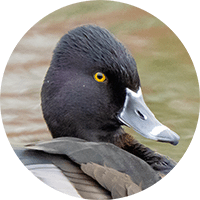Ring-necked Duck
Appearance: The male Ring-necked Duck (43 cm - 17 inches) has a black head, neck, and upper body, with a white crescent on its face and a gray back. It also has a distinct vertical white stripe on its chest and sides, along with a pointed gray bill with white ring near tip, and yellow eyes. The female has a brownish-gray body with a lighter face and a dark cap, gray cheeks, white eye-ring, white at base of bill, faint shoulder spur.
Habitat: Ring-necked Ducks prefer freshwater habitats such as lakes, ponds, marshes, and wetlands. They can be found in both open water areas and regions with dense emergent vegetation, providing cover and foraging opportunities. Found at elevations up to 2600 m.
Behavior: These ducks are skilled divers and foragers. They feed on aquatic plants, seeds, insects, and small invertebrates. They dive underwater to search for food, using their feet to propel themselves. Ring-necked ducks are known for their energetic and rapid diving behavior.
Breeding: Ring-necked Ducks breed in the boreal forests of North America, rather than Colombia. They construct nests in dense vegetation near water bodies. Females lay a clutch of about 8-10 eggs, and both parents participate in incubation and caring for the young.
Conservation Status: Ring-necked Ducks are considered rare or occasional visitors to Colombia. They are not known to breed in the country. In terms of conservation status, they are regarded as a species of least concern as populations are stable across their wide geographic range.
Distribution
Northern Andes: During the winter months (November to March), Ring-necked Ducks can be found in certain high-altitude lakes and wetlands in the northern Andes of Colombia. Specifically, they have been reported in locations such as Chingaza National Natural Park, Laguna de Fúquene, and Laguna de La Herrera.
Other Regions: While less common, there have been occasional records of Ring-necked Ducks in other parts of Colombia, such as the wetland areas of the eastern and western lowlands, including La Cocha Lake in the department of Nariño, and Ciénaga Grande de Santa Marta on the Caribbean coast.
The Ring-necked Duck's presence in Colombia is mainly seasonal, and they are not known to breed in the country. They primarily migrate from their breeding grounds in North America to overwinter in Colombia and other parts of South America.
Taxonomy
- Kingdom: Animalia
- Phylum: Chordata
- Class: Aves
- Order: Anseriformes
- Family: Anatidae
- Genus: Aythya
- Species: Aythya collaris
Vocalization
Quacks: Similar to many ducks, the Ring-necked Duck produces a series of quack-like calls. These quacks are typically rapid, short, and soft, lacking the loudness and intensity often associated with mallard-like ducks.
Whistles: Ring-necked Ducks can also emit whistling sounds, which are often described as high-pitched and somewhat squeaky. These whistling vocalizations are typically heard during courtship displays or in territorial disputes.
Grunts or growls: During aggressive encounters, particularly between males competing for mates or territory, Ring-necked Ducks may produce growling or grunting sounds. These sounds are deep and throaty, with a low and guttural quality.





